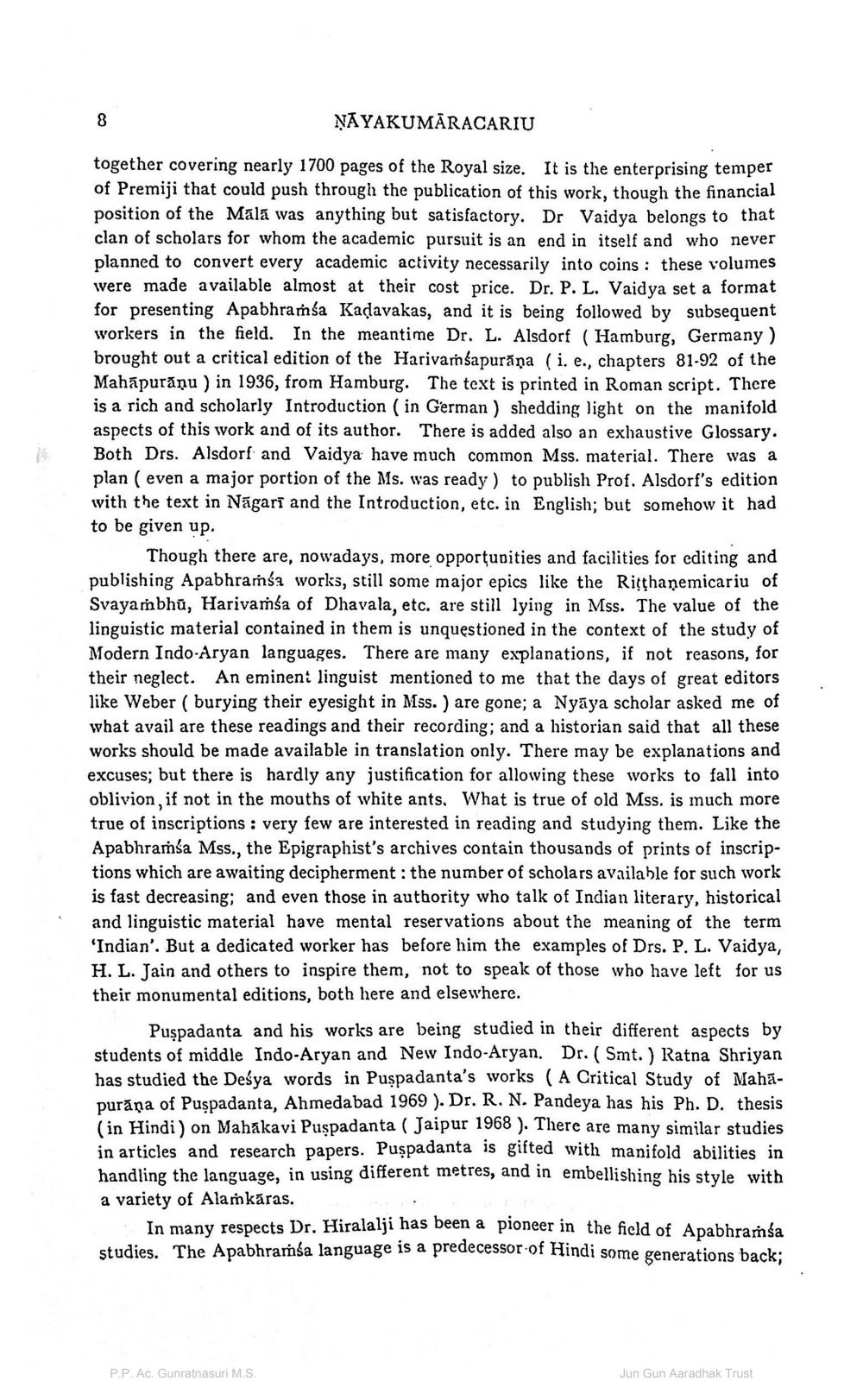Book Title: Nag Kumar Charita Author(s): Pushpadant Mahakavi Publisher: Bharatiya Gyanpith View full book textPage 8
________________ NAYAKUMARACARIU together covering nearly 1700 pages of the Royal size. It is the enterprising temper of Premiji that could push through the publication of this work, though the financial position of the Mala was anything but satisfactory. Dr Vaidya belongs to that clan of scholars for whom the academic pursuit is an end in itself and who never planned to convert every academic activity necessarily into coins : these volumes were made available almost at their cost price. Dr. P. L. Vaidya set a format for presenting Apabhramsa Kadavakas, and it is being followed by subsequent workers in the field. In the meantime Dr. L. Alsdorf ( Hamburg, Germany) brought out a critical edition of the Harivamsapurana (i. e., chapters 81-92 of the Mahapuranu ) in 1936, from Hamburg. The text is printed in Roman script. There is a rich and scholarly Introduction (in German ) shedding light on the manifold aspects of this work and of its author. There is added also an exhaustive Glossary. Both Drs. Alsdorf and Vaidya have much common Mss. material. There was a plan ( even a major portion of the Ms. was ready) to publish Prof. Alsdorf's edition with the text in Nagari and the Introduction, etc. in English; but somehow it had to be given up. Though there are, nowadays, more opportunities and facilities for editing and publishing Apabhramsa works, still some major epics like the Ritthanemicariu of Svayambhu, Harivamba of Dhavala, etc. are still lying in Mss. The value of the linguistic material contained in them is unquestioned in the context of the study of Modern Indo-Aryan languages. There are many explanations, if not reasons, for their neglect. An emineni linguist mentioned to me that the days of great editors like Weber ( burying their eyesight in Mss.) are gone; a Nyaya scholar asked me of what avail are these readings and their recording; and a historian said that all these works should be made available in translation only. There may be explanations and excuses; but there is hardly any justification for allowing these works to fall into oblivion, if not in the mouths of white ants. What is true of old Mss. is much more true of inscriptions : very few are interested in reading and studying them. Like the Apabhraisa Mss., the Epigraphist's archives contain thousands of prints of inscriptions which are awaiting decipherment: the number of scholars available for such work is fast decreasing; and even those in authority who talk of Indian literary, historical and linguistic material have mental reservations about the meaning of the term 'Indian'. But a dedicated worker has before him the examples of Drs. P. L. Vaidya, H. L. Jain and others to inspire them, not to speak of those who have left for us their monumental editions, both here and elsewhere. Puspadanta and his works are being studied in their different aspects by students of middle Indo-Aryan and New Indo-Aryan. Dr. ( Smt.) Ratna Shriyan has studied the Desya words in Puspadanta's works ( A Critical Study of Mahapurana of Puspadanta, Ahmedabad 1969 ). Dr. R. N. Pandeya has his Ph. D. thesis (in Hindi) on Mahakavi Puspadanta ( Jaipur 1968 ). There are many similar studies in articles and research papers. Puspadanta is gifted with manifold abilities in handling the language, in using different metres, and in embellishing his a variety of Alamkaras. respects Dr. Hiralalji has been a pioneer in the field of Apabhramsa studies. The Apabhramba language is a predecessor of Hindi so P.P. Ac. Gunratnasuri M.S. Jun Gun Aaradhak TrustPage Navigation
1 ... 6 7 8 9 10 11 12 13 14 15 16 17 18 19 20 21 22 23 24 25 26 27 28 29 30 31 32 33 34 35 36 37 38 39 40 41 42 43 44 45 46 47 48 49 50 51 52 53 54 55 56 57 58 59 60 61 62 63 64 65 66 67 68 69 70 71 72 73 74 75 76 77 78 79 80 81 82 ... 352
